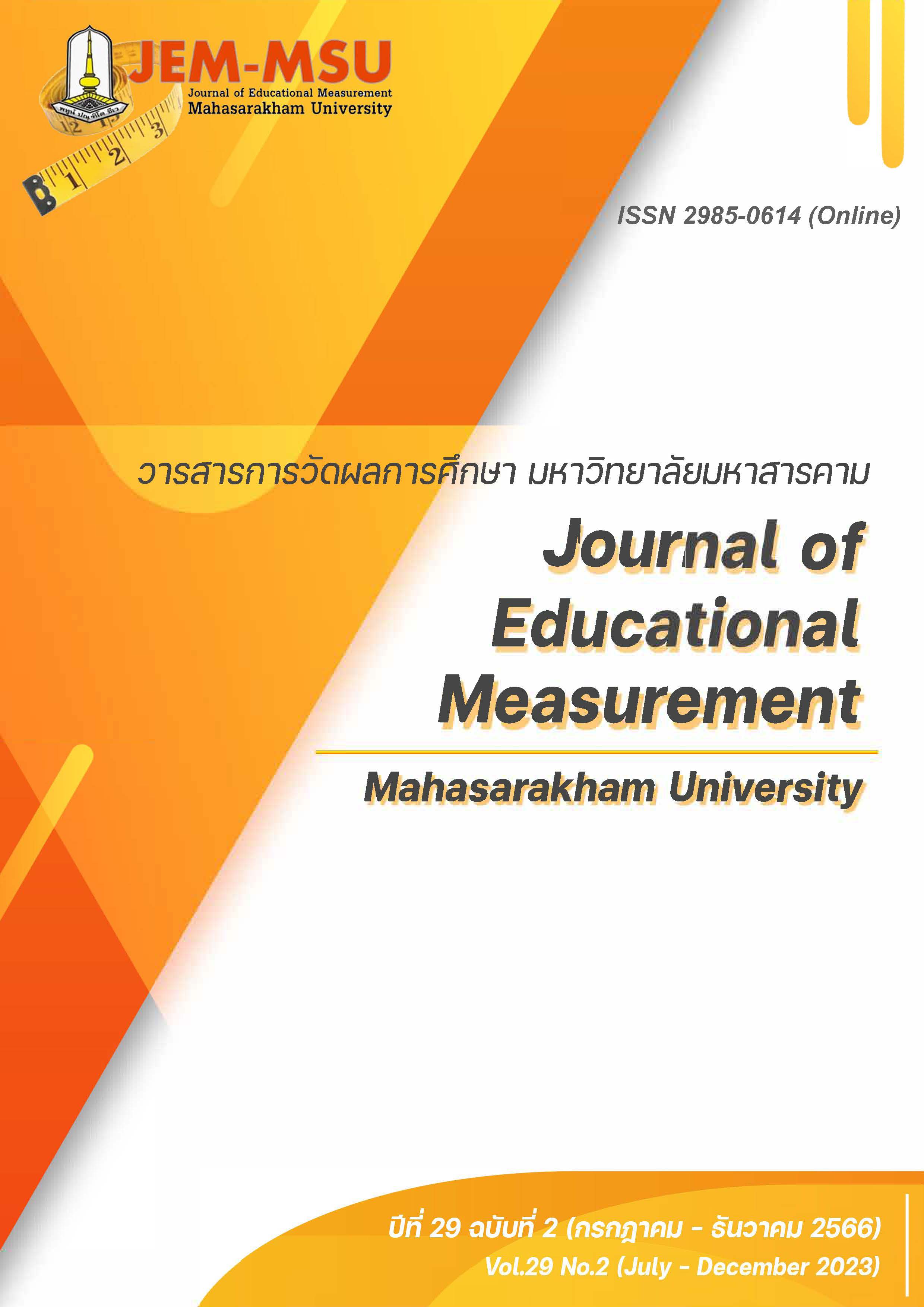A Model of Disruptive Leadership Development of School Administrators under Khon Kaen Primary Education Service Area Office 4
Main Article Content
Abstract
The purposes of the research were 1) to examine the consistency of the component model of disruptive leadership of school administrators under Khon Kaen Primary Education Service Area Office 4 with empirical data, and 2) to construct and evaluate a model of the disruptive leadership of school administrators under Khon Kaen Primary Education Service Area Office 4, in terms of suitability, possibility, and utility. Utilizing the mixed-methods research, the research was divided into 2 phases. Phase 1 used the quantitative research. The sample comprised 400 school administrators and teachers under Khon Kaen Primary Education Service Area Office 4. The instrument was a 5-point rating scale questionnaire, having the reliability of 0.805. The Mplus7.0 program was used to analyze the data in the confirmatory factor analysis and to examine the consistency between the model and the empirical data. Chi- square () was used to examine the hypothesis. Phase 2 used the qualitative research. The results of the study in Phase 1 were used to build a draft model. Then 5 experts were interviewed in order to examine and confirm the model, and 7 experts evaluated the model.
The research results were as follows: 1) The model for developing disruptive leadership of school administrators under Khon Kaen Primary Education Service Area Office 4, which was developed by the author, was consistent with the empirical data, as = 78.022, df = 64,
/df =1.219, P-Value = 0.111, RMSEA = 0.023, SRMR = 0.027, CFI = 0.994, TLI = 0.991. The component with the highest component weight was the adaptability, followed by the digital technology adaptation, and the lowest was the networking and cooperation. 2) The model for developing disruptive leadership of school administrators under Khon Kaen Primary Education Service Area Office 4 was composed of the model’s name, principles and concepts, objectives, goals, and guidelines. The results showed that the suitability, the possibility, and the utility were at the highest level.
Article Details

This work is licensed under a Creative Commons Attribution-NonCommercial-NoDerivatives 4.0 International License.
The content and information contained in the published article in the Journal of Educational Measurement Mahasarakham University represent the opinions and responsibilities of the authors directly. The editorial board of the journal is not necessarily in agreement with or responsible for any of the content.
The articles, data, content, images, etc. that have been published in the Journal of Educational Measurement Mahasarakham University are copyrighted by the journal. If any individual or organization wishes to reproduce or perform any actions involving the entirety or any part of the content, they must obtain written permission from the Journal of Educational Measurement Mahasarakham University.
References
Clark, S. (2022). Five disruptive leadership strategy skills. https://www.linkedin.com/pulse/five-disruptive-leadership-strategy-skills-steve-clark
Dufresne, P. (2020). Disruptive leadership and how to pivot into success: an Open Letter to School Leaders. https://www.knovva.com/disruptive-disruptive-leadership-and-how-to-pivot-into-success-an-open-letter-to-school-leaders/
Eisner, E. (1976). Education connoisseurship and criticism: their form and function in education evaluation. Journal of Aesthetic Education, 10(3), 135-150.
Hair, J.F., Black, W.C., Babin, B.J., & Anderson, R.E. (2010). Multivariate data analysis (7th ed.). Prentice Hall.
Hair, J.F., Black, W.C., Babin, B.J., & Anderson, R.E. (2019). Multivariate Data Analysis. Cengage Learning EMEA.
Jotform, Inc. (2021). Methods to utilize technology for school administrators. https://www.jotform.com/blog/how-principals-can-support-edtech/
Mercer, L. (2019). Disruptive leadership in disruption: Are you ready?. https://www.mercer.com/content/dam/mercer/attachments/global/Career/gl-2019-career-vot-disruptive-leadership-in-disruption.pdf
Newsome, P. (2020). Empowerment in the workplace: What it is and why it matters. https://www.4cornerresources.com/blog/empowerment-in-the-workplace-what-it-is-and-why-it-matters/
Promise, Z. (2021). Strengthening institutions of higher education through disruptive leadership. International Scientific Journal of Universities and disruptive leadership, 1(11), 181-191.
Ryan, C.N. (2016). Disruptive Leadership: A Grounded Theory Study of How Three Kentucky Women are Leading Change [Doctoral dissertation]. Western Kentucky University.
Steenkamp, J., B. (2021). Admiral Jacky Fisher and the art of disruptive leadership. Management and Business Review, 1(2). 79-85.
Zucker, R. & Rowell, R. (2021). 6 strategies for leading through uncertainty. https://hbr.org/2021/04/6-strategies-for-leading-through-uncertainty
Buason, R. (2013). Qualitative research in education (4th ed). Chulalongkorn University. (in Thai)
Chutcham, S. (2004). A Confirmatory Factor Analysis. Journal of Educational Research and Measurement Burapha University, 2(1), 15-42. (in Thai)
Department of Policy and Plan. (2023). Annual Action Plan of the Financial Year 2023. Khon Kaen Primary Educational Service Area Office 4. (in Thai)
Department of Teacher and Educational Personnel Development. (2022). The Monitoring Report of Education Personnel’s Operational Potential. http://www.khonkaen4.go.th (in Thai)
Duangchuen, P. (2018). Change views on organization management in Disruptive World. Journal of Educational Administration, Silpakorn University, 8(2), 248-256. (in Thai)
Hongchayanggoon, K.& Tiengjanya, P. (2017). Network and partnership management. http://hsmi2.psu.ac.th/upload/forum/paper (in Thai)
Ministry of Education. (2020). Three-year action plan (2020-2023) of the Office of the Basic Education Commission. Office of Policy and Basic Education Plan. (in Thai)
Office of the National Economic and Social Development Council. (2018). National Strategy 2018-2037. National Strategy Secretariat Office, Office of the National Economic and Social Development Board. (in Thai)
Office of the National Economic and Social Development Council. (2022). The Thirteenth National Economic and Social Development Plan (2023-2027). The Office of the Permanent Secretary. (in Thai)
Srisa-ard, B. (2017). Preliminary research (10th ed.). Suwiriyasan. (in Thai)
Thawinkarn, D. (2017). Art and Science of Educational Administration. Faculty of Education, Khon Kaen University. (in Thai)
Theerathien, T. (2020). Disruption with teachers in the 21st century. https://www.starfishlabz.com/blog/4-digital-disruption. (in Thai)


